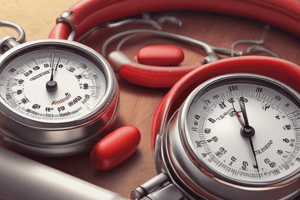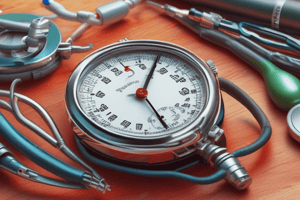Podcast
Questions and Answers
Which of the following factors directly influences both systolic and diastolic blood pressure?
Which of the following factors directly influences both systolic and diastolic blood pressure?
- Total peripheral resistance
- Cardiac output (correct)
- Heart rate
- Stroke volume
Which of the following interventions is most likely to directly improve preload and subsequently increase cardiac output?
Which of the following interventions is most likely to directly improve preload and subsequently increase cardiac output?
- Increasing heart rate
- Reducing afterload
- Increasing venomotor tone (correct)
- Administering a positive inotropic drug
A patient with hypertension is advised to reduce salt intake. Which of the following physiological mechanisms is primarily targeted by this lifestyle modification?
A patient with hypertension is advised to reduce salt intake. Which of the following physiological mechanisms is primarily targeted by this lifestyle modification?
- Decreased cardiac output
- Increased venomotor tone
- Reduced contractility
- Increased total peripheral resistance (correct)
A patient's blood pressure reading is 140/90 mmHg. Which of the following factors is most likely contributing to the elevated diastolic pressure?
A patient's blood pressure reading is 140/90 mmHg. Which of the following factors is most likely contributing to the elevated diastolic pressure?
Which of the following lifestyle interventions is LEAST likely to have a direct impact on blood pressure regulation?
Which of the following lifestyle interventions is LEAST likely to have a direct impact on blood pressure regulation?
A patient with hypertension is experiencing increased afterload. Which of the following interventions is MOST likely to directly address this issue?
A patient with hypertension is experiencing increased afterload. Which of the following interventions is MOST likely to directly address this issue?
Which of the following factors is LEAST likely to contribute to an increase in preload?
Which of the following factors is LEAST likely to contribute to an increase in preload?
A patient with hypertension has been prescribed a medication that decreases contractility. Which of the following physiological changes is MOST likely to occur as a direct consequence of this medication?
A patient with hypertension has been prescribed a medication that decreases contractility. Which of the following physiological changes is MOST likely to occur as a direct consequence of this medication?
A patient is experiencing a hypertensive emergency with a systolic blood pressure of 220 mmHg. Which of the following medications is the most appropriate first-line treatment?
A patient is experiencing a hypertensive emergency with a systolic blood pressure of 220 mmHg. Which of the following medications is the most appropriate first-line treatment?
Which class of antihypertensive drugs primarily acts by blocking the conversion of angiotensin I to angiotensin II, reducing vasoconstriction and aldosterone release?
Which class of antihypertensive drugs primarily acts by blocking the conversion of angiotensin I to angiotensin II, reducing vasoconstriction and aldosterone release?
What is the mechanism of action of centrally acting sympatholytic drugs like clonidine in reducing blood pressure?
What is the mechanism of action of centrally acting sympatholytic drugs like clonidine in reducing blood pressure?
A patient is experiencing severe bradycardia and bronchospasm after receiving a beta blocker. What is the most likely reason for these adverse effects?
A patient is experiencing severe bradycardia and bronchospasm after receiving a beta blocker. What is the most likely reason for these adverse effects?
Which of the following drugs is most likely to cause reflex tachycardia when used to lower blood pressure?
Which of the following drugs is most likely to cause reflex tachycardia when used to lower blood pressure?
A patient is experiencing significant postural hypotension after starting a new antihypertensive medication. Which class of drug is most likely responsible for this side effect?
A patient is experiencing significant postural hypotension after starting a new antihypertensive medication. Which class of drug is most likely responsible for this side effect?
Which of the following medications directly stimulates ATP-sensitive potassium channels in smooth muscle cells, causing hyperpolarization and vasodilation?
Which of the following medications directly stimulates ATP-sensitive potassium channels in smooth muscle cells, causing hyperpolarization and vasodilation?
Which of the following drug classes primarily blocks the action of angiotensin II at its receptors, preventing its vasoconstricting and other effects?
Which of the following drug classes primarily blocks the action of angiotensin II at its receptors, preventing its vasoconstricting and other effects?
A patient presents with severe cough and angioedema after starting an angiotensin-converting enzyme (ACE) inhibitor. What is the most likely explanation for these side effects?
A patient presents with severe cough and angioedema after starting an angiotensin-converting enzyme (ACE) inhibitor. What is the most likely explanation for these side effects?
Which of the following drugs is a potent arterial and venous dilator that is commonly used in the management of hypertensive emergencies?
Which of the following drugs is a potent arterial and venous dilator that is commonly used in the management of hypertensive emergencies?
What is the primary mechanism by which hydralazine and nitroprusside lower blood pressure?
What is the primary mechanism by which hydralazine and nitroprusside lower blood pressure?
A patient taking a calcium channel blocker experiences bradycardia and peripheral edema. Which of the following statements is TRUE regarding these side effects?
A patient taking a calcium channel blocker experiences bradycardia and peripheral edema. Which of the following statements is TRUE regarding these side effects?
A patient is taking a centrally acting sympatholytic drug and experiences dizziness and dry mouth. What is the most likely explanation for these side effects?
A patient is taking a centrally acting sympatholytic drug and experiences dizziness and dry mouth. What is the most likely explanation for these side effects?
Which of the following best describes the mechanism of action of guanethidine, a post-ganglionic sympathetic nerve ending blocker?
Which of the following best describes the mechanism of action of guanethidine, a post-ganglionic sympathetic nerve ending blocker?
Which of the following statements is true about directly acting vasodilators, such as hydralazine, minoxidil, and diazoxide?
Which of the following statements is true about directly acting vasodilators, such as hydralazine, minoxidil, and diazoxide?
A patient is experiencing severe rebound hypertension after abruptly discontinuing clonidine. What is the best explanation for this phenomenon?
A patient is experiencing severe rebound hypertension after abruptly discontinuing clonidine. What is the best explanation for this phenomenon?
What is a significant risk associated with the administration of nitroprusside?
What is a significant risk associated with the administration of nitroprusside?
Which of the following medications is classified as a potassium channel opener?
Which of the following medications is classified as a potassium channel opener?
In managing aortic dissection with nitroprusside, what additional medication is recommended to avoid reflex tachycardia?
In managing aortic dissection with nitroprusside, what additional medication is recommended to avoid reflex tachycardia?
Why are diuretics not typically used in hypertensive emergencies?
Why are diuretics not typically used in hypertensive emergencies?
Which medication can be administered for rapid control of blood pressure with a rapid onset and offset of action?
Which medication can be administered for rapid control of blood pressure with a rapid onset and offset of action?
Flashcards
Lifestyle Modifications for Hypertension
Lifestyle Modifications for Hypertension
Changes like exercise and diet to manage mild hypertension.
Potassium-Rich Diet
Potassium-Rich Diet
Eating foods like bananas to help lower blood pressure.
Blood Pressure Regulation
Blood Pressure Regulation
Blood pressure is influenced by cardiac output and resistance.
Cardiac Output
Cardiac Output
Signup and view all the flashcards
Stroke Volume
Stroke Volume
Signup and view all the flashcards
Preload
Preload
Signup and view all the flashcards
Afterload
Afterload
Signup and view all the flashcards
Effects of Venomotor Tone
Effects of Venomotor Tone
Signup and view all the flashcards
Sodium Nitroprusside
Sodium Nitroprusside
Signup and view all the flashcards
Cyanide Toxicity
Cyanide Toxicity
Signup and view all the flashcards
Labetalol
Labetalol
Signup and view all the flashcards
Fenoldopam
Fenoldopam
Signup and view all the flashcards
Aortic Dissection
Aortic Dissection
Signup and view all the flashcards
Venodilators
Venodilators
Signup and view all the flashcards
Diastolic Duration
Diastolic Duration
Signup and view all the flashcards
Central Sympatholytic Drugs
Central Sympatholytic Drugs
Signup and view all the flashcards
Clonidine
Clonidine
Signup and view all the flashcards
Alpha-1 Adrenergic Blockers
Alpha-1 Adrenergic Blockers
Signup and view all the flashcards
Beta-1 Adrenergic Blockers
Beta-1 Adrenergic Blockers
Signup and view all the flashcards
Directly Acting Vasodilators
Directly Acting Vasodilators
Signup and view all the flashcards
Hydralazine
Hydralazine
Signup and view all the flashcards
Calcium Channel Blockers
Calcium Channel Blockers
Signup and view all the flashcards
ACE Inhibitors
ACE Inhibitors
Signup and view all the flashcards
Diuretics
Diuretics
Signup and view all the flashcards
Hypertensive Emergencies
Hypertensive Emergencies
Signup and view all the flashcards
Angiotensin II Receptor Blockers
Angiotensin II Receptor Blockers
Signup and view all the flashcards
Post-Ganglionic Blockers
Post-Ganglionic Blockers
Signup and view all the flashcards
Study Notes
Nonpharmacological Management of Hypertension
- Lifestyle modifications are crucial for managing mild hypertension.
- This involves regular physical exercise, at least 20-30 minutes three times per week.
- Salt restriction is recommended, avoiding further salt addition to food.
- Weight loss is essential for obese patients.
- Smoking cessation is critical, exacerbating hypertension-related complications.
- Moderate alcohol intake is advised; excessive alcohol irritates nerve endings, increases sympathetic activity, and raises blood pressure.
- Relaxation techniques and biofeedback are beneficial for managing stress-induced hypertension.
- Potassium-rich diets, including bananas and fruits, are recommended.
- Lipid management is vital due to the link between hypertension and atherosclerosis. Limiting red meat helps reduce cholesterol.
Physiological Parameters and Blood Pressure Regulation
- Blood pressure primarily depends on cardiac output and total peripheral resistance.
- Cardiac output influences systolic blood pressure, and total peripheral resistance influences diastolic blood pressure.
- Diastolic pressure is the resistance offered by arterioles in blood flow from arteries to veins.
- Arterial constriction increases resistance, resulting in higher diastolic pressure.
- Arterial dilation decreases resistance, causing lower diastolic pressure.
- Systolic blood pressure results from the blood ejected by the left ventricle during systole.
- Increased cardiac output leads to higher systolic pressure.
- Lower cardiac output causes lower systolic pressure.
Factors Affecting Cardiac Output
- Cardiac output depends on stroke volume and heart rate.
- Stroke volume, the blood ejected with each heartbeat, is influenced by contractility, preload, and afterload.
- Contractility, the force of ventricular contraction, is enhanced by positive inotropic drugs and reduced by negative inotropic drugs.
- Preload, the ventricular blood volume at diastole's end, is affected by venous return.
- Afterload, the resistance the ventricle must overcome, is essentially the total peripheral resistance.
Factors Affecting Preload
- Preload (end-diastolic volume) is determined by total blood volume, venomotor tone, and diastolic duration.
- Increased venomotor tone increases venous return, leading to higher preload, stroke volume, and cardiac output.
- Venodilators decrease venomotor tone, lowering preload, stroke volume, and cardiac output.
- Higher blood volume increases venous return, resulting in higher preload, stroke volume, and cardiac output.
- Diastolic duration (heart relaxation and filling time) impacts end-diastolic volume. Longer diastole facilitates greater filling.
- Faster heart rate shortens diastole, reducing filling time.
Central Sympatholytic Drugs
- These drugs target the central nervous system, specifically the vasomotor center in the medulla, to reduce sympathetic outflow.
- Clonidine and alpha-methyldopa are centrally acting sympatholytics.
- Clonidine stimulates presynaptic alpha-2 adrenergic receptors, inhibiting norepinephrine release.
- Alpha-methyldopa converts to alpha-methyldopamine then alpha-methylnorepinephrine, acting as false neurotransmitters and inhibiting norepinephrine release.
- Central sympatholytics can cause salt/water retention, sedation, dry mouth, impotence, dizziness, and rebound hypertension upon abrupt cessation.
Ganglion Blockers
- Rarely used due to significant side effects.
- Block both sympathetic and parasympathetic ganglia, causing widespread autonomic dysfunction.
- Hexamethonium is an example of a ganglion blocker.
Post-Ganglionic Sympathetic Nerve Ending Blockers
- These drugs interfere with norepinephrine release from sympathetic nerve endings.
- Guanethidine, reserpine, and metyrosine are examples.
- Guanethidine enters and displaces norepinephrine, inhibiting its release.
- Reserpine blocks storage vesicle transporters, preventing norepinephrine storage and depleting it.
- Metyrosine inhibits tyrosine hydroxylase, preventing dopamine and norepinephrine synthesis.
Alpha Adrenergic Receptor Blockers
- Block alpha-1 adrenergic receptors, causing arterial and venous dilation.
- Phenoxybenzamine and phentolamine are non-selective alpha blockers, affecting both alpha-1 and alpha-2 receptors.
- Prazosin, terazosin, and doxazosin are selective alpha-1 blockers, primarily targeting alpha-1 receptors.
- Alpha blockers can cause postural hypotension, nasal congestion, sexual dysfunction, and reflex tachycardia.
Beta Adrenergic Receptor Blockers
- Block beta-1 adrenergic receptors, reducing heart rate, contractility, and cardiac output.
- Propranolol is a non-selective beta blocker, affecting both beta-1 and beta-2 receptors.
- Atenolol is a selective beta-1 blocker, focusing on beta-1 receptors.
- Beta blockers lower blood pressure by reducing cardiac output and inhibiting the renin-angiotensin-aldosterone system.
- They can cause fatigue, bradycardia, bronchospasm, and rebound hypertension.
Directly Acting Vasodilators
- Directly relax vascular smooth muscle, independent of the sympathetic nervous system.
- Hydralazine, minoxidil, and diazoxide are primarily arterial dilators.
- Nitroprusside is a potent arterial and venous dilator.
- These drugs can cause reflex tachycardia, salt/water retention, and postural hypotension.
Diazoxide
- Stimulates ATP-sensitive potassium channels in smooth muscle, hyperpolarizing and causing vasodilation.
Hydralazine and Nitroprusside
- Release nitric oxide, activating guanylate cyclase and increasing cyclic GMP levels.
- Cyclic GMP activates protein kinase G, phosphorylating and inactivating myosin light chain kinase, preventing smooth muscle contraction.
- Hydralazine primarily dilates arteries, while nitroprusside dilates both arteries and veins.
Minoxidil
- Similar to diazoxide, activating potassium channels for hyperpolarization and vasodilation.
Calcium Channel Blockers
- Block L-type calcium channels, reducing calcium influx into myocardial cells and vascular smooth muscle.
- Verapamil, diltiazem, and nifedipine are calcium channel blockers.
- Verapamil primarily affects the heart; diltiazem affects both; nifedipine mainly targets vascular smooth muscle.
- Calcium channel blockers can cause bradycardia, hypotension, and peripheral edema.
Renin-Angiotensin-Aldosterone System (RAAS) Inhibitors
- ACE inhibitors block angiotensin I to angiotensin II conversion, reducing vasoconstriction and aldosterone release.
- Captopril, enalapril, and lisinopril are examples of ACE inhibitors.
- ACE inhibitors can cause cough, angioedema, and fetal abnormalities.
Angiotensin II Receptor Blockers
- Block angiotensin II receptors, preventing vascular smooth muscle, adrenal cortex, and sympathetic nerve effects.
- Losartan, valsartan, and irbesartan are examples.
- They are less likely to cause cough and angioedema compared to ACE inhibitors but can affect pregnancy.
Diuretics
- Increase urine output by reducing sodium and chloride reabsorption in the kidneys.
- Thiazide diuretics (e.g., hydrochlorothiazide) are commonly used antihypertensive diuretics.
- Loop diuretics (e.g., furosemide) are also used but less frequently.
- Diuretics can cause hypokalemia, hypomagnesemia, and hyperuricemia.
Hypertensive Emergencies
- Defined as a systolic blood pressure above 210 mmHg or diastolic pressure over 150 mmHg in a healthy individual, or diastolic blood pressure over 130 mmHg accompanied by severe complications or target organ damage.
- Management involves rapidly, but carefully, reducing blood pressure to prevent complications like intracranial hemorrhage.
Treatment of Hypertensive Emergencies
- Sodium nitroprusside, a potent arterial and venous dilator, is the primary drug for hypertensive emergencies.
- Administered by continuous intravenous infusion, allowing precise blood pressure control.
- Nitroprusside has rapid onset and offset, ideal for urgent blood pressure control.
- Associated with cyanide toxicity risk, manageable with sodium thiosulfate.
- Other drugs used include:
- Labetalol (alpha and beta blocker)
- Fenoldopam (dopamine-1 receptor agonist)
- Nicardipine (calcium channel blocker)
- Diazoxide (potassium channel opener)
- Diuretics are generally not used in emergencies due to slower onset.
Special Use of Sodium Nitroprusside
- Sodium nitroprusside is also used for managing aortic dissection.
- It lowers blood pressure, decreasing the aortic pressure gradient and slowing dissection.
- Due to possible reflex tachycardia, beta blockers may be given alongside nitroprusside for aortic dissection.
Studying That Suits You
Use AI to generate personalized quizzes and flashcards to suit your learning preferences.




